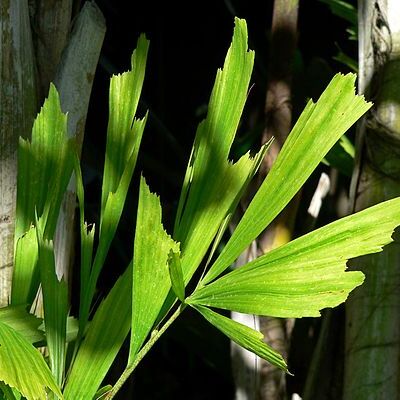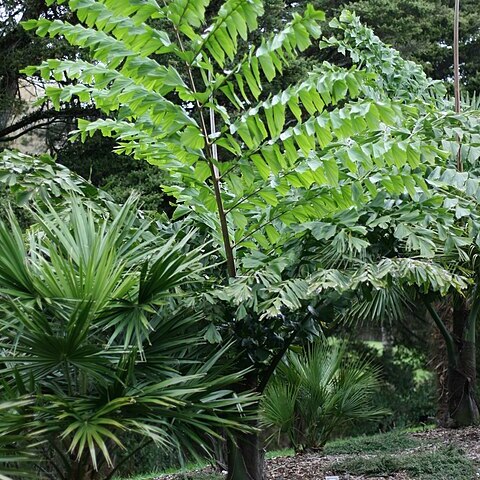Stems solitary or clustered, slender to massive, smooth, with conspicuous nodal rings. Leaves: blade 2-pinnate (1-pinnate in juvenile plants); plication induplicate; segments cuneate, in 1 plane; apices jagged and irregular; basal segments not modified into spines. Inflorescences initiated basipetally, first one appearing terminal, successive one borne axillary among leaves, and later ones below leaves, pendulous, paniculate, with 1 order of branching [spicate]; prophyll small; peduncular bracts numerous, tubular. Flowers unisexual, sessile, borne in triads of 1 pistillate flower flanked by 2 staminate flowers. Staminate flowers: sepals 3, imbricate, free; petals 3, connate basally, valvate; stamens numerous [6], free; pistillode absent. Pistillate flowers: sepals 3, imbricate, free; petals 3, connate for nearly 1/2 length, valvate; staminodial lobes present or absent; pistils 1, 3-loculate; ovules 1 per locule; styles indistinct; stigmas 3-lobed. Fruits berries, globular; exocarp purple, smooth; mesocarp fleshy, containing irritating raphides; endocarp absent. Seeds globular; endosperm ruminate [homogeneous]; embryo lateral; eophyll 2-cleft, segments fan-shaped. n = 17.
Clustering (not in Australia) or solitary, monoecious, unarmed, hapaxanthic palms. Leaves bipinnate. Pinnae induplicate, cuneate, apically praemorse, truncate. Inflorescence spicate (not in Australia) or branched to 1 or more orders, produced basipetally from axillary nodes; prophyll inconspicuous; peduncular bracts several, spirally arranged on short peduncle. Flowers in triads, most frequently proximal on rachilla, with single or paired staminate flowers in distal portion. Staminate flower with imbricate sepals; petals valvate; stamens few–many; pistillode absent. Pistillate flower with petals basally connate; staminodes sometimes present; ovary trilocular with 1–3 fertile locules. Fruit globose (not in Australia) to sub-globose, 1–3-seeded; stigmatic remains apical, or lateral (not in Australia); mesocarp with irritant crystals; endocarp not differentiated. Seed tear-shaped (not in Australia), hemispherical or globose, smooth, black; endosperm ruminate or homogeneous (not in Australia); embryo lateral (not in Australia) or sub-basal. Eophyll bifid.


